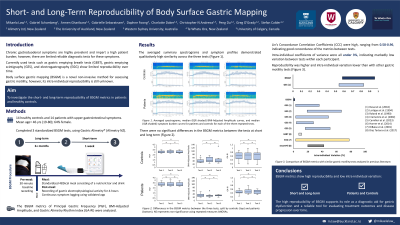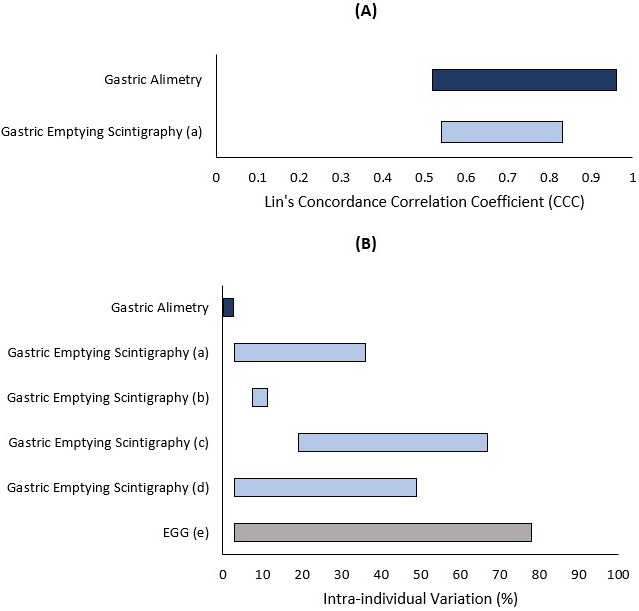Monday Poster Session
Category: Stomach
P2748 - Short- and Long-Term Reproducibility of Body Surface Gastric Mapping
Monday, October 23, 2023
10:30 AM - 4:15 PM PT
Location: Exhibit Hall

Has Audio

Mikaela Law, PhD
University of Auckland
Auckland, Auckland, New Zealand
Presenting Author(s)
Award: Presidential Poster Award
Mikaela Law, PhD1, Armen Gharibans, PhD1, Gabriel Schamberg, PhD2, Gabrielle Sebaratnam, 2, Daphne Foong, 3, Charlotte Daker, MBBS4, Christopher N. Andrews, MD5, Peng Du, PhD1, Greg O'Grady, MBChB, PhD1, Stefan Calder, PhD1
1University of Auckland, Auckland, Auckland, New Zealand; 2Alimetry Ltd., Auckland, Auckland, New Zealand; 3Western Sydney University, Western Sydney, New South Wales, Australia; 4Te Whatu Ora - Waitematā, Auckland, Auckland, New Zealand; 5University of Calgary, Calgary, AB, Canada
Introduction: The global prevalence of Disorders of Gut-Brain Interaction (DGBIs) is increasing, contributing to growing healthcare burden. Current diagnostic methods, such as gastric emptying scintigraphy, are known to exhibit lability over time, contributing to diagnostic uncertainty. Body surface gastric mapping (BSGM) is a non-invasive method for detecting gastric electrophysiological biomarkers to aid gastric motility diagnostics. This study aimed to investigate the short- and long-term reproducibility of BSGM metrics.
Methods: 14 patients with upper gastrointestinal symptoms and 14 healthy controls completed three, standardised BSGM tests, using Gastric Alimetry®), comprising a stretchable high-resolution array (8x8 electrodes), a wearable reader and a validated symptom-logging app. The test encompassed a fasting baseline (30 minutes), a 482kCal meal, and a 4 hour postprandial recording. The first two tests were conducted 6-12 months apart (for long-term reproducibility) and the last test occurred 1 week later (for short-term reproducibility). Standard BSGM metrics analysed included; Principal Gastric Frequency, Gastric Alimetry Rhythm Index, BMI-adjusted amplitude, and fed:fasted amplitude ratio. Reproducibility was analysed using Lin’s concordance correlation coefficient (CCC) and intra- and inter-individual coefficients of variance (COV).
Results: The average values of the BSGM metrics did not significantly differ between the tests at either short- or long-term, even when controlling for symptoms (all p>.07). The CCC for the metrics ranged from 0.52-0.96, demonstrating high short- and long-term reproducibility. The inter-individual COVs ranged from 9.3-45.7%, whilst the intra-individual COVs ranged from 0.18-2.6%. These data were compared to reproducibility statistics for other gastric motility tests, showing higher reproducibility and lower intra-individual variation than scintigraphy and electrogastrography (Figure 1).
Discussion: BSGM metrics showed high reproducibility and low intra-individual variation at both short- (1 week) and long-term (6-12 months), with superior reproducibility compared to other gastric motility tests. This indicates that the results from BSGM are not likely to be affected by day-to-day variability and remain consistent over time. The reproducibility of BSGM supports its role as a diagnostic aid for gastric dysfunction and as a reliable tool to evaluate longitudinal changes in treatment outcomes and disease progression.

Disclosures:
Mikaela Law, PhD1, Armen Gharibans, PhD1, Gabriel Schamberg, PhD2, Gabrielle Sebaratnam, 2, Daphne Foong, 3, Charlotte Daker, MBBS4, Christopher N. Andrews, MD5, Peng Du, PhD1, Greg O'Grady, MBChB, PhD1, Stefan Calder, PhD1. P2748 - Short- and Long-Term Reproducibility of Body Surface Gastric Mapping, ACG 2023 Annual Scientific Meeting Abstracts. Vancouver, BC, Canada: American College of Gastroenterology.
Mikaela Law, PhD1, Armen Gharibans, PhD1, Gabriel Schamberg, PhD2, Gabrielle Sebaratnam, 2, Daphne Foong, 3, Charlotte Daker, MBBS4, Christopher N. Andrews, MD5, Peng Du, PhD1, Greg O'Grady, MBChB, PhD1, Stefan Calder, PhD1
1University of Auckland, Auckland, Auckland, New Zealand; 2Alimetry Ltd., Auckland, Auckland, New Zealand; 3Western Sydney University, Western Sydney, New South Wales, Australia; 4Te Whatu Ora - Waitematā, Auckland, Auckland, New Zealand; 5University of Calgary, Calgary, AB, Canada
Introduction: The global prevalence of Disorders of Gut-Brain Interaction (DGBIs) is increasing, contributing to growing healthcare burden. Current diagnostic methods, such as gastric emptying scintigraphy, are known to exhibit lability over time, contributing to diagnostic uncertainty. Body surface gastric mapping (BSGM) is a non-invasive method for detecting gastric electrophysiological biomarkers to aid gastric motility diagnostics. This study aimed to investigate the short- and long-term reproducibility of BSGM metrics.
Methods: 14 patients with upper gastrointestinal symptoms and 14 healthy controls completed three, standardised BSGM tests, using Gastric Alimetry®), comprising a stretchable high-resolution array (8x8 electrodes), a wearable reader and a validated symptom-logging app. The test encompassed a fasting baseline (30 minutes), a 482kCal meal, and a 4 hour postprandial recording. The first two tests were conducted 6-12 months apart (for long-term reproducibility) and the last test occurred 1 week later (for short-term reproducibility). Standard BSGM metrics analysed included; Principal Gastric Frequency, Gastric Alimetry Rhythm Index, BMI-adjusted amplitude, and fed:fasted amplitude ratio. Reproducibility was analysed using Lin’s concordance correlation coefficient (CCC) and intra- and inter-individual coefficients of variance (COV).
Results: The average values of the BSGM metrics did not significantly differ between the tests at either short- or long-term, even when controlling for symptoms (all p>.07). The CCC for the metrics ranged from 0.52-0.96, demonstrating high short- and long-term reproducibility. The inter-individual COVs ranged from 9.3-45.7%, whilst the intra-individual COVs ranged from 0.18-2.6%. These data were compared to reproducibility statistics for other gastric motility tests, showing higher reproducibility and lower intra-individual variation than scintigraphy and electrogastrography (Figure 1).
Discussion: BSGM metrics showed high reproducibility and low intra-individual variation at both short- (1 week) and long-term (6-12 months), with superior reproducibility compared to other gastric motility tests. This indicates that the results from BSGM are not likely to be affected by day-to-day variability and remain consistent over time. The reproducibility of BSGM supports its role as a diagnostic aid for gastric dysfunction and as a reliable tool to evaluate longitudinal changes in treatment outcomes and disease progression.

Figure: Figure 1. Comparison of Gastric Alimetry reproducibility statistics with similar gastric motility tests analysed in previous literature using: (A) Lin’s Concordance Correlation Coefficient, and (B) intra-individual variation.
(a) Desai et al., (2018); (b) Horner et al., (2014); (c) Lartigue et al., (1994); (d) Roland, et al., (1990); (e) DiBaise et al., (2001)
(a) Desai et al., (2018); (b) Horner et al., (2014); (c) Lartigue et al., (1994); (d) Roland, et al., (1990); (e) DiBaise et al., (2001)
Disclosures:
Mikaela Law: Alimetry Ltd. – Employee.
Armen Gharibans: Alimetry Ltd. – Employee, Owner/Ownership Interest.
Gabriel Schamberg: Alimetry Ltd. – Employee.
Gabrielle Sebaratnam: Alimetry Ltd. – Employee.
Daphne Foong: Alimetry Ltd. – Employee.
Charlotte Daker: Alimetry Ltd. – Employee.
Christopher Andrews: Alimetry Ltd. – Employee.
Peng Du: Alimetry Ltd. – Employee.
Greg O'Grady: Alimetry Ltd. – Employee, Owner/Ownership Interest. The Insides Company – Owner/Ownership Interest.
Stefan Calder: Alimetry Ltd. – Employee.
Mikaela Law, PhD1, Armen Gharibans, PhD1, Gabriel Schamberg, PhD2, Gabrielle Sebaratnam, 2, Daphne Foong, 3, Charlotte Daker, MBBS4, Christopher N. Andrews, MD5, Peng Du, PhD1, Greg O'Grady, MBChB, PhD1, Stefan Calder, PhD1. P2748 - Short- and Long-Term Reproducibility of Body Surface Gastric Mapping, ACG 2023 Annual Scientific Meeting Abstracts. Vancouver, BC, Canada: American College of Gastroenterology.

